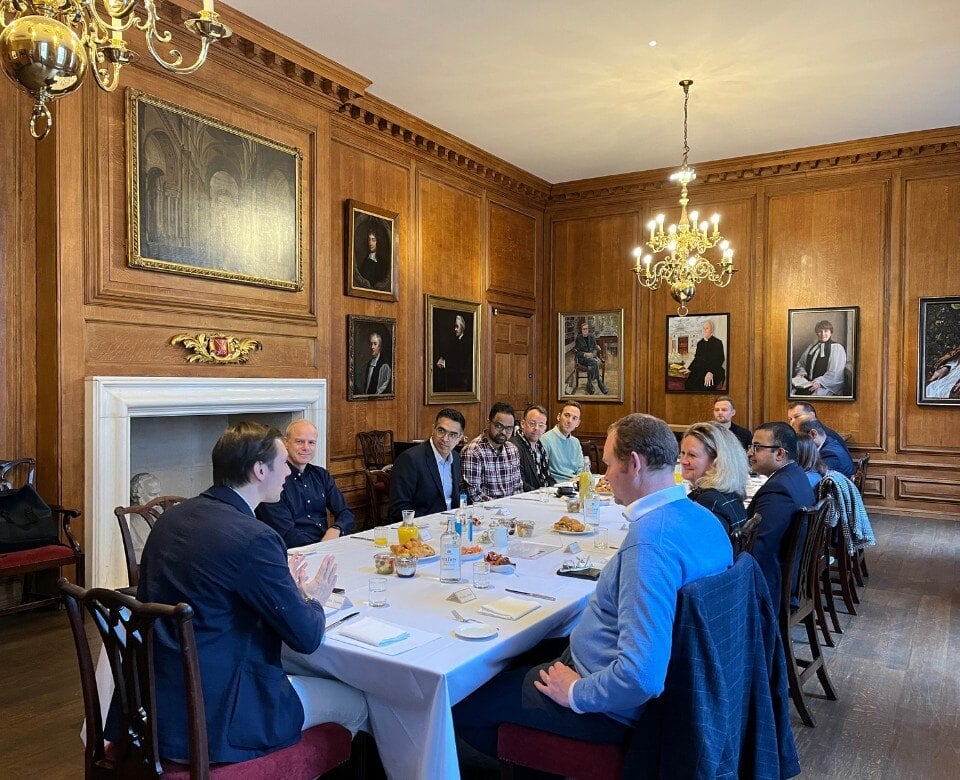
At this exclusive Food for Thought breakfast, technology leaders shared insights on navigating the complexities of digital transformation—from overcoming change fatigue to prioritising data management and workforce reskilling. Discover how CIOs are balancing these demands to align IT and business strategy, ensuring their organisations remain agile and resilient in the face of rapid change.
By now everyone is aware of how the role of the Chief Information Officer, CIO, has evolved. CIOs are central to business strategy, leading digital transformation and directly shaping the future of organisations. What is still unclear however is how the additional pressures of innovation—driven by advancements in AI, data analytics and automation—wrestle with these new demands of business strategy that require balancing technological advancement with organisational adaptability.
This is where the ruthless dynamics of innovation come into play: navigating the ever-changing landscape of change while overcoming internal resistance and ensuring alignment between business and IT, continually.
To cover these overlapping challenges and opportunities, HotTopics and HCL Tech brought together technology leaders to St Paul's Cathedral in London for a roundtable debate and private lunch, as part of our regular Food for Thought series for C-suite leaders.
Read the summary of the debate, below, to understand how technology leaders are approaching the balance between innovative agility and risk-based change management, across four parameters.
1. CIO leadership through ongoing transformation
The most successful CIOs today must operate at the intersection of technology and business strategy. Digital transformation is no longer just about updating systems; it is about reshaping entire organisations to meet the demands of a digital-first economy, supply chain and customer or client base. Successful transformations are, first, continual, and second, more than just an update in technical expertise—it calls for CIOs to work on what we call “soft power”: collaboration and influence.
Leadership buy-in, particularly at the executive level, is critical. A CIO must work closely with senior leadership to ensure that technological initiatives align with overall business goals. As noted by several leaders during a recent industry discussion, IT and business operating in silos is counterproductive. “Blurring the lines between business and IT” has become essential for achieving long-term success. This could be as simple as not referring to the rest of the business as “the business”. Psychologically, it puts up a barrier separating IT; the most effective CIOs ensure that IT is seen not just as a service provider but as an integral part of business growth.
2. Overcoming and managing change fatigue
While leadership buy-in is essential, middle management often presents the greatest challenge to digital transformation. These managers, entrenched in existing processes, can be resistant to change, particularly when it threatens established workflows and hierarchies. Overcoming this resistance requires clear communication of the business value behind digital initiatives. It’s not enough to dictate changes from the top; transformation today is directly linked to how comfortable your teams are with change.
Several executives have highlighted the importance of storytelling in overcoming resistance. By framing digital transformation as a growth enabler rather than a threat, CIOs can bridge the gap between IT and middle management. Establishing partnerships between business and IT teams can also foster a culture of collaboration. As one leader noted, “Success often starts with getting one business unit on board, proving the value of digital, and then encouraging others to follow suit”.
3. Prioritising data management—finally
For an asset that is regularly discussed as “the lifeblood of modern business” and “the new oil”, scant few Chief Data Officers feel data is prioritised, even today, at the advent of genAI. Many organisations struggle with fragmented data systems, often spread across various departments and repositories. Without a centralised approach to data management, AI and digital initiatives are likely to fall short of their potential. This means a rethink on how the CIO and CDO departments work together, where they sit, and what skills they need moving forward.
A key challenge for CIOs is ensuring that the organisation’s data infrastructure is robust enough to support innovation. Building centralised data lakes and ensuring data governance is a priority for any organisation looking to leverage AI effectively. As one executive remarked, “If the data isn’t there, AI won’t work. You can’t expect innovation without a solid foundation of accurate, real-time information”.
4. How CIOs should reskill the workforce
Innovation is not just a technological challenge—it’s a cultural one. As organisations embrace digital transformation, there is an increasing need for reskilling and upskilling employees to ensure they can thrive in a more digital environment. However, this often requires overcoming significant resistance, particularly among employees who fear that automation and AI may render their roles obsolete.
CIOs must play a key role in addressing these concerns, helping to reshape the organisational culture to one that embraces change. Upskilling initiatives, combined with clear communication about the future roles of employees, are crucial in reducing fears and building a workforce that is equipped to support the company’s digital ambitions. The transition from traditional roles to more strategic, value-adding positions is essential, and it is up to CIOs to guide this evolution within their organisations.
Closing thoughts
The ruthless dynamics of innovation mean that CIOs must constantly juggle technological advancements, organisational resistance, and the need for cultural transformation. To keep up, we heard that they must finally embrace their roles as business strategists, ensuring that digital transformation efforts are not just technical upgrades but part of a broader organisational shift. Leadership buy-in, effective data management, and reskilling are all critical components of this process. By addressing these challenges head-on, CIOs will be in a better position to help organisations thrive—and future-proof their own careers.
This Food for Thought breakfast was created in partnership with HCL Tech.
SUBMIT A COMMENT
RELATED ARTICLES
Join the community
To join the HotTopics Community and gain access to our exclusive content, events and networking opportunities simply fill in the form below.

